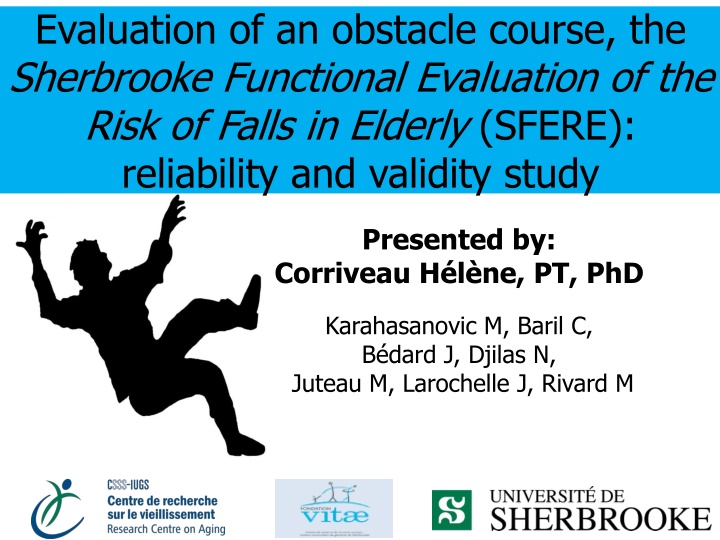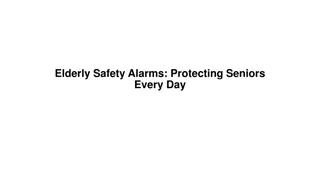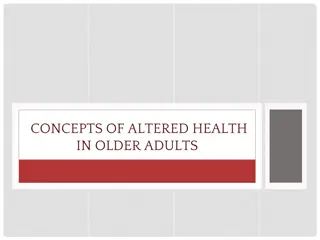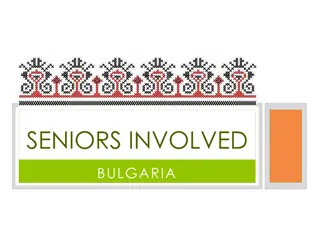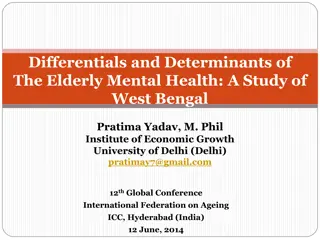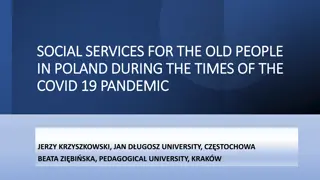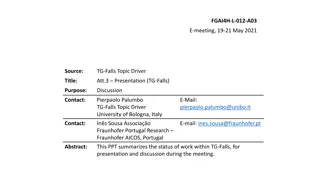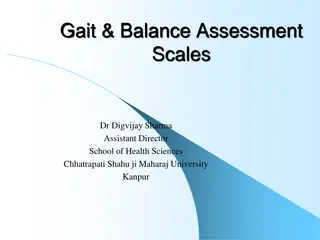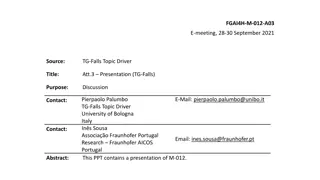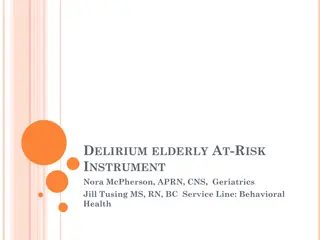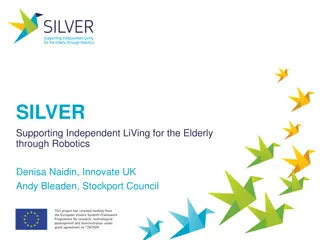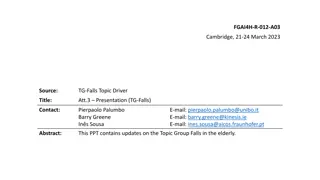Evaluation of SFERE Obstacle Course for Fall Risk in Elderly
The Sherbrooke Functional Evaluation of the Risk of Falls in Elderly (SFERE) presents a reliable and valid tool to assess fall risk in older adults. This study highlights the importance of identifying fallers through a tool that mimics daily living tasks. Developed by Marcel Rivard, PT, the SFERE involves a series of 10 tasks related to activities of daily living, endurance, and impulsivity, with a total score of 30 points. The SFERE course description includes tasks like sit-to-stand transfers, door manipulation, obstacle navigation, and walking exercises.
Download Presentation

Please find below an Image/Link to download the presentation.
The content on the website is provided AS IS for your information and personal use only. It may not be sold, licensed, or shared on other websites without obtaining consent from the author.If you encounter any issues during the download, it is possible that the publisher has removed the file from their server.
You are allowed to download the files provided on this website for personal or commercial use, subject to the condition that they are used lawfully. All files are the property of their respective owners.
The content on the website is provided AS IS for your information and personal use only. It may not be sold, licensed, or shared on other websites without obtaining consent from the author.
E N D
Presentation Transcript
Evaluation of an obstacle course, the Sherbrooke Functional Evaluation of the Risk of Falls in Elderly (SFERE): reliability and validity study Presented by: Corriveau H l ne, PT, PhD Karahasanovic M, Baril C, B dard J, Djilas N, Juteau M, Larochelle J, Rivard M
Overview Introduction Evaluation of risk of falls: obstacle course SFERE Objectives of the study Method Population Data collection Results Discussion Conclusion
Introduction Problematic 1/3 people over 65 years fall at least once each year1 86% of hospitalizations of people over 65 years old are caused by falls2 Consequences of falls: Hospital and long-term care institutions3,4; Quality of life diminution5-8 Economic burden3: In Canada, falls over 65 cost 2.5G$ per year9 1/3 of those falls could potentially be prevented10 1Word health Organization, 2007;2Statistiques Canada;3Papaioannou, 2001; 4Wiktorowicz, 2001; 8Papaioannou, 2009;9OMSS, 2005;10Campbell, 2002 5Sawka, 2005; 6Cranney, 2005; 7Pasco,2005;
Problematic Reliable and valid tool allowing the identification of fallers Are not usefull because they: 1) Controlled the environment; 2) Evaluated a single task at a time; 3) Do not mimic the reality of daily living
Introduction Solution! A tool representative of daily living including double tasking1,2 As an Obstacle Course like is the Sherbrooke Functional Evaluation of the Risk of Falls in Elderly (SFERE) 1Dub , 2008; 2 Means , 1998
Introduction Developed by Marcel Rivard, PT1 Total of 10 tasks Activities of daily living including double tasking1,2 Assessment of the participant s endurance Assessment of the participant s impulsivity Score varying from 0 to 3 for each task Total score of 30 points The times taken to complete the test is 20 minutes 1Rivard, 2000
SFERE : COURSE DESCRIPTON 1. Sit to stand transfer from a chair with armrests and 1,83m (6 ) walk 2. Move 2 towels using only the foot 3. Open a door, cross the door sill and close the door 4. Walk 1,83m (6 ), sit and stand up from a chair without armrests 5. Open a door, cross the door sill and close the door 6. Zigzag through 6 obstacles 7. Walk 6,1m (20 ) while counting from 20 to 10 8. Walk 4,57m (15 ) while identifying 4 visual targets
Objectives of the study 1. Estimate simultaneous inter-rater Intraclass correlation coefficient Cohen Kappa 2. Determine the specificity ); Is the tool adequate to identify fallers? Faller: decisional algorithm Receiver Operating Characteristic (ROC) curve the reliability :test-retest and validity (sensitivity and
Method Population Reliability study Validity study 1) Able to walk with or without walking aids; 2) Able to follow simple instructions; 3) Medically stable; 4) 65 years or older Important comorbidity preventing them from accomplishing the obstacle course Inclusion criteria: Exclusion criteria: Reliability study Validity study 1) Social demographic (questionnaire); 2) Mobility (TUG); 3) Dual tasking (TUG manual); 4) Lower limb strength (Sit to Stand) Interrater and test-retest reliability 1stsession: 2 raters/participant; 2nd session (2-5 days later): one rater/participant Intraclass correlation coefficients (ICC) Data collection Validity: 1 session Criterion concurrent validity: sensibility and specificity with receiver operating characteristic (ROC) curves for: 1) Total score of the SFERE; 2) Time to complete the SFERE; 3)Time to complete the TUG Construct convergent validity: Pearson s correlation coefficient Spearman Rho Data analysis
RESULTS Population characteristics Reliability Validity Population n=41 n=95 (including 45 fallers) Mean age (years) 72.2 83.7 Sex 35 women 83 women Mean number of drug taken 5 6
Results - Reliability Simultaneous inter-rater ICC*: 0.90 CI**: (0.81- 0.95) Mean SD E1-E2 1st Evaluator (E1) 2nd Evaluator (E2) 22.80 4.47 23.56 4.80 0.76 (p< 0.0001) Significant bias *Wilcoxon test * Intraclass Correlation Coefficients ** Confidence Interval 95 %
Results - reliability Test-retest ICC*: 0.73 CI**: (0.55- 0.85) Result Mean SD 22.80 4.47 23.78 4.18 E1-E2 Test 1 (E1) Test 2 (E2) -0.98 (p< 0.0001) Significant bias: - Learning phenomenon - Anxiety diminution * Intraclass Correlation Coefficients ** Confidence interval 95 %
Results Reliability of each item Tasks Kappa CI (95%) 1. Transfer (sit to stand) 0.44 (0.18 - 0.70) 2. Move 2 towels 0.474 (0.24 0.71) 3. Cross a door 0.511 (0.27 0.75) 4. Transfer in a chair without armrests 0.344 (0.08 0.61) 5. Cross a door in reverse 0.565 (0.29 0.83) 6. Zigzaging 0.27 (-0.09 0.63) 7. Walk while counting 0.119 (-0.21 0.45) 8. Walk while looking at something 0.154 (-0.22 0.53) 9. Endurance 0.696 (0.48 0.91) 10. Comportement 0.396 (0.16 0.63)
Results Convergent Construct Validity Variables Instruments Obstacle course p value BERG 0.536* <0.0001 Time up and go (TUG) -0.331 0.34 Balance Walking speed -0.343 0.28 Cognitive 3MS 0.506 0.001 Perceptual Motor Perceptual test (MVPT) Free Visual 0.256 0.106 Executive functions Assessment of Motor and processing skills (AMPS) 0.069 0.668 Fear of falling ABC 0.005 0.976 *Pearson Correlation
Results - Validity Sensitivity and specificity Cut-off Sensibility 0.911 0.911 Specificity 0.620 0.800 SFERE score 27/30 SFERE time 89,2s Sensitivity and specificity for other screening tools Sensibility Specificity BERG 0,84 0,78 TUG 0,87 0,87 TUG manual 0,80 0,93 Sit-to-stand 0,67 0,72
Results - Validity Criterion concurrent validity Cut-off Sensibility Specificity SFERE score 27/30 0.911 0.620 SFERE time 89.2s 0.911 0.800 Construct convergent validity SFERE score and SFERE time -0,804 SFERE time and TUG time 0,846 SFERE score and TUG time Sensitivity and specificity for screening tools -0,731 Sensibility Specificity BERG 0.84 0.78 TUG 0.87 0.87 TUG manual 0.80 0.93 Sit-to-stand 0.67 0.72
Discussion The SFERE have excellent inter-rater reliability (ICC = 0.90) and good test-retest reliability (ICC = 0.73) But the results are influenced by an unequal performance of the participants during a short period. Clinicians must be aware that different factors, such as anxiety and learning, could influence the performance during the obstacle course. The participants must practice at least one before the assessment
Discussion The cut-off of the time variable (89.2s) has values of sensitivity (0.911) and specificity (0.800) that are even better than those of the total score ( 27), sensitivity (0.911) and specificity (0.680). An elderly having a score inferior to 89.2 sec is a faller. The specificity is good, IT is important that a tool assessing the risk of falls has a good capacity of ruling out a non-faller
Conclusion In comparison with traditional instruments, the numerous functional tasks present within the SFERE help health care professionals in developing preventive measures, in order to reduce the risk of falls. Guides the interventions related to less successfully tasks Gives recommendations for the safety within the home a plan of treatment and
Acknowledgement All the participants who contributed to this study Vitae Foundation and the Ordre Professionel de la Physioth rapie du Qu bec (OPPQ) for their financial support.
Rfrences BEAUCHET, O., DUBOST, V., NEVERS, A., STIERLAM, F., A BLANCHON, M., MOUREY, F., PFITZENMEYER, P. and GONTHIER, R., 2002. Development of a clinical test of gait in frail elderly by a cognitive approach of locomotion. Annales de readaptation et de medecine physique : revue scientifique de la Societe francaise de reeducation fonctionnelle de readaptation et de medecine physique, 45(3), pp. 123-130. BONGUE, B., DUPRE, C., BEAUCHET, O., ROSSAT, A., FANTINO, B. and COLVEZ, A., 2011. A screening tool with five risk factors was developed for fall-risk prediction in community-dwelling elderly. Journal of clinical epidemiology, 64(10), pp. 1152-1160. CHAIWANICHSIRI, D., JANCHAI, S. and TANTISIRIWAT, N., 2009. Foot disorders and falls in older persons. Gerontology, 55(3), pp. 296-302. COLL GE NATIOANAL DES ENSEIGNANTS DE G RIATRIE., 2010-last update, Corpus de G riatrie. Available: http://www.longuevieetautonomie.fr/index.php?option=com_content&view=article&id=47&Itemid=53 [07/12, 2012]. DUBE, F., ROUSSEAU, J., KAEGI, C., BOUDREAULT, R. and NADEAU, S., 2008. Development of a Walking-Safety Scale for Older Adults, Part II: Interrater and Test-Retest Agreement of the GEM Scale. Physiotherapy Canada.PhysiotherapieCanada, 60(3), pp. 274-282. EGGERMONT, L.H., PENNINX, B.W., JONES, R.N. and LEVEILLE, S.G., 2012. Depressive symptoms, chronic pain, and falls in older community- dwelling adults: the MOBILIZE Boston Study. Journal of the American Geriatrics Society, 60(2), pp. 230-237. GAXATTE, C., NGUYEN, T., CHOURABI, F., SALLERON, J., PARDESSUS, V., DELABRIERE, I., THEVENON, A. and PUISIEUX, F., 2011. Fear of falling as seen in the Multidisciplinary falls consultation. Annals of physical and rehabilitation medicine, 54(4), pp. 248-258. JEANDEL, C., 1998. Les chutes du sujet g . Soins g rontologique, (12),. KAEGI, C., BOUDREAULT, R., ROUSSEAU, J., BOURBONNAIS, D., NADEAU, S. and DUBE, F., 2008. Development of a Walking Safety Scale for Older Adults, Part I: Content Validity of the GEM Scale. Physiotherapy Canada.PhysiotherapieCanada, 60(3), pp. 264-273. KOJIMA, T., AKISHITA, M., NAKAMURA, T., NOMURA, K., OGAWA, S., IIJIMA, K., ETO, M. and OUCHI, Y., 2012. Polypharmacyas a risk for fall occurrence in geriatric outpatients. Geriatrics & gerontology international, 12(3), pp. 425-430. LORD, S.R., MENZ, H.B. and SHERRINGTON, C., 2006. Home environment risk factors for falls in older people and the efficacy of home modifications. Age and Ageing, 35 Suppl 2, pp. ii55-ii59.
References MEANS, K.M., RODELL, D.E. and O'SULLIVAN, P.S., 1998. Obstacle course performance and risk of falling in community-dwelling elderly persons. Archives of Physical Medicine and Rehabilitation, 79(12), pp. 1570-1576. MEANS, K.M., RODELL, D.E. and O'SULLIVAN, P.S., 1996. Use of an obstacle course to assess balance and mobility in the elderly. A validation study. American Journal of Physical Medicine & Rehabilitation / Association of Academic Physiatrists, 75(2), pp. 88-95. MORRIS, R., HARWOOD, R.H., BAKER, R., SAHOTA, O., ARMSTRONG, S. and MASUD, T., 2007. A comparison of different balance tests in the prediction of falls in older women with vertebral fractures: a cohort study. Age and Ageing, 36(1), pp. 78-83. MYERS, H. and NIKOLETTI, S., 2003. Fall risk assessment: a prospective investigation of nurses' clinical judgement and risk assessment tools in predicting patient falls. International journal of nursing practice, 9(3), pp. 158-165. NEULS, P.D., CLARK, T.L., VAN HEUKLON, N.C., PROCTOR, J.E., KILKER, B.J., BIEBER, M.E., DONLAN, A.V., CARR-JULES, S.A., NEIDEL, W.H. and NEWTON, R.A., 2011. Usefulness of the Berg Balance Scale to predict falls in the elderly. Journal of geriatric physical therapy (2001), 34(1), pp. 3- 10. NORDIN, E., LINDELOF, N., ROSENDAHL, E., JENSEN, J. and LUNDIN-OLSSON, L., 2008. Prognostic validity of the Timed Up-and-Go test, a modified Get-Up-and-Go test, staff's global judgement and fall history in evaluating fall risk in residential care facilities. Age and Ageing, 37(4), pp. 442- 448. RUBENSTEIN, L.Z., JOSEPHSON, K.R., TRUEBLOOD, P.R., YEUNG, K., HARKER, J.O. and ROBBINS, A.S., 1997. The reliability and validity of an obstacle course as a measure of gait and balance in older adults. Aging (Milan, Italy), 9(1-2), pp. 127-135. SIBLEY, K.M., STRAUS, S.E., INNESS, E.L., SALBACH, N.M. and JAGLAL, S.B., 2011. Balance assessment practices and use of standardized balance measures among Ontario physical therapists. Physical therapy, 91(11), pp. 1583-1591. THRANE, G., JOAKIMSEN, R.M. and THORNQUIST, E., 2007. The association between timed up and go test and history of falls: the Tromsostudy. BMC geriatrics, 7, pp. 1. TINETTI, M.E., WILLIAMS, T.F. and MAYEWSKI, R., 1986. Fall risk index for elderly patients based on number of chronic disabilities. The American Journal of Medicine, 80(3), pp. 429-434. TODD C, S.D., 2004-last update, What are the main risk factors for falls among older people and what are the most<br/>effective interventions to prevent these falls?. Available: http://www.euro.who.int/document/E82552.pdf [07/12, 2012]. WALKER, P.C., ALRAWI, A., MITCHELL, J.F., REGAL, R.E. and KHANDERIA, U., 2005. Medication use as a risk factor for falls among hospitalized elderly patients. American Journal of Health-System Pharmacy : AJHP : Official Journal of the American Society of Health-System Pharmacists, 62(23), pp. 2495-2499.
Results - Validity Clinical variables Mean SD Standard deviation 26 0 3 SFERE score (/30) 126.8 6.0 58.9 SFERE time (s) 19.6 1.2 11.5 TUG (s) 15.1 1.0 4.7 TUG manual (s) 27.01 1.77 17.2 STS (s)
